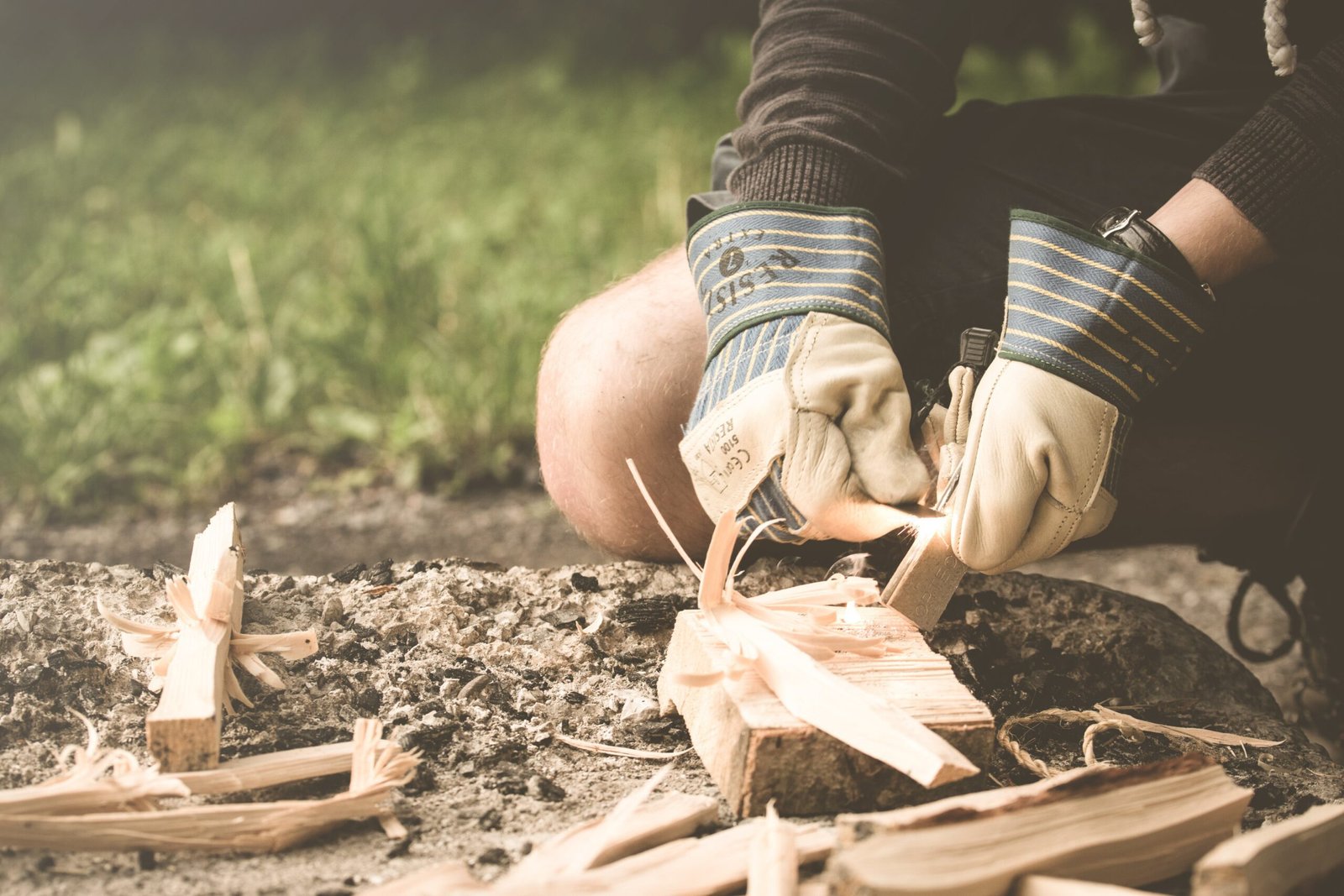This article may contain affiliate links. read more
Jump To
Embarking on a camping adventure promises an escape into nature’s tranquility, but unforeseen challenges can arise. This comprehensive camping survival guide combines insights from various sources to equip you for a safe and enjoyable outdoor experience. Discover how to navigate wildlife encounters, weather storms, and address common camping concerns, ensuring you’re well-prepared for any scenario.
1. Early Camping Preparations Before You Leave the House
Ensure a smooth start to your camping journey by meticulously preparing before leaving home. From essential contact numbers to gear checks, follow these steps for a worry-free departure.
Essential Contact Information
Before hitting the road, compile crucial contact details, including local authorities and campground information. Having this information readily available ensures quick response in case of emergencies. Ensure you have the phone numbers of local police or park rangers, the address of the campground, and your camp confirmation number.
Gear Check
Thoroughly inspect all camping gear to guarantee a hassle-free experience upon arrival at your campsite. Open all gear, including tents and portable stoves, and check that all parts are present and in usable condition. This proactive approach ensures that you won’t be caught off guard with malfunctioning equipment in the midst of your camping adventure.
2. Campsite Setup
Designing an effective emergency campsite is a crucial aspect of outdoor preparedness. This guide provides insights into creating a secure environment, protecting you from wildlife encounters and extreme weather conditions. Discover essential skills for crafting your campsite that will keep you safe and comfortable during your outdoor adventures.
Constructing Natural Shelters:
In situations where you may get lost or your tent is damaged, the ability to utilize natural materials for shelter is invaluable. Follow these steps:
Material Selection:
- Gather dry leaves, branches, and pine needles.
- Prefer elevated areas away from water sources to avoid moisture.
Shelter Setup:
- Mimic a tent or teepee structure.
- Create a raised bed at least eight inches off the ground.
For more detailed guidance, explore our article on various natural shelters.
Mastering Knot Tying:
Whether securing materials, anchoring your shelter, or managing various tasks around the camp, tying sturdy knots is a fundamental survival skill. Practice these types until they become second nature:
- Clove Hitch
- Bowline
- Square Knot
- Double Fisherman’s Knot
Read this article for complete knot tutorial essential survival knots.
Igniting Fires from Scratch:
While starting a fire with tools is common, true survival skills involve starting one from scratch. Follow these steps:
Choosing a Location:
- Select a patch of bare, dry soil.
- Consider digging a pit if feasible.
Building the Fire:
- Collect dry branches, twigs, bark, and leaves.
- Ignite using sunlight, a magnifying glass, a bow or hand drill, or flint and steel.
3. Coexisting with Local Wildlife:
As you share the outdoor space with various wildlife, understanding how to peacefully coexist is paramount. Follow these tips:
Deterrence Techniques:
- Use fabric softener sheets to repel animals.
- Never leave food or cookware unattended.
Self-Defense Strategies:
- Make yourself appear bigger, louder, and scarier.
- Fight back only when necessary, using rocks, sticks, or knive
Remember, aim for an animal’s vulnerable areas: throat, chin, eyes, stomach, or the back of the head.
4. Dealing with Wildlife Encounters
Navigate the wilderness with confidence by understanding how to handle encounters with bears and other critters. From bear safety to preventing unwanted visits, these tips ensure a harmonious coexistence.
Bear Safety Tips
Encountering a bear can be intimidating, but understanding bear behavior and following safety measures can mitigate risks. Cook and store food away from sleeping areas, never keep food in your tent, and be cautious of items that may attract bears, such as cooking utensils and toiletries. Carrying and knowing how to use bear-repellent spray adds an extra layer of protection.
Preventing Other Wildlife Visits
Learn how to safeguard your campsite from possums, raccoons, coyotes, and skunks by employing effective prevention techniques. Store food in airtight containers, keep cooking waste sealed, and maintain a well-lit campfire. The presence of a dog can also deter wildlife. If animals invade your campsite, make loud noises, shine a flashlight on them, and they are likely to retreat.
5. Preparing for Rain and Other Weather Challenges
Nature’s unpredictability demands preparedness. Whether facing rain, wind, or snow, these strategies will help you weather the storm and stay comfortable.
Storm Preparedness
When dark clouds gather, implement these storm-preparedness techniques to safeguard your campsite and maintain dryness. Move non-essential items into your vehicle, secure clothes and feet against moisture, and use your vehicle as a windbreak by positioning it close to your tent or camper.
Utilizing Vehicles as Shelters
Your vehicle can be a valuable ally during storms; discover how to strategically use it as a shelter against the elements. In adverse weather conditions, your vehicle can provide temporary refuge, offering protection against rain, wind, or snow. Positioning it strategically can significantly enhance your camping experience during challenging weather.
Emergency Rain Gear
Equip yourself with the right gear to stay dry, ensuring a comfortable camping experience despite unexpected downpours. Pack waterproof matches, have a change of clothes ready, and cover your tent and important items with extra tarps. Being prepared for rain ensures that you can continue to enjoy the outdoors even when the weather takes an unexpected turn.
6. Navigation and Safety in the Wilderness
Getting lost in the wilderness is a genuine concern. Enhance your wilderness navigation skills, understand campfire safety, and learn basic survival techniques to ensure a secure camping experience.
Avoiding Getting Lost
Navigate the wilderness confidently by traveling with a partner, utilizing a cell phone, and understanding how to read maps and use a compass. Always travel with a partner, especially when venturing away from your campsite. Program emergency phone numbers into your cell phone and carry signal flares for visibility. If you find yourself lost, locate man-made objects and mark your path for potential rescuers.
Out-of-Control Campfires
Prevent campfires from turning into wildfires by following essential safety measures, and know what to do if a fire gets out of hand. Clear space around your campfire, keep it small, and never leave it unattended. In case of an uncontrolled fire, smother it with dirt or wet towels. Evacuate immediately if the situation escalates, and contact local authorities.
Wilderness Survival Techniques
Equip yourself with basic survival skills, from building shelters to finding water sources, enhancing your preparedness for unforeseen challenges. Learn essential survival techniques, such as building shelters with available materials, identifying edible plants, and purifying water. These skills can be invaluable in emergencies, ensuring you can navigate and survive unexpected situations in the wilderness.
7. Ensuring a Peaceful Campground Experience
A harmonious camping experience involves managing campground neighbors and safeguarding your belongings from potential theft or vandalism.
Managing Campground Neighbors
Proactively address any disruptions by surveying potential campsites for privacy and effectively communicating with neighboring campers. Choose a secluded campsite for added privacy, and communicate politely with neighboring campers to establish expectations. If disturbances persist, involve park rangers or campground management for resolution.
Safety Concerns at Parks and Campgrounds
Implement security measures to protect your belongings, ensuring a secure and peaceful environment for your camping adventure. Lock windows and doors when away, secure bicycles and equipment, and maintain a tidy campsite for quick identification of any disturbances. Keep emergency numbers accessible and report any suspicious activities to park authorities.
8. Health and Emergency Response
Be prepared for health emergencies by equipping yourself with basic first aid skills, a comprehensive first aid kit, and the knowledge of emergency contact numbers.
Seeking Emergency Medical Attention
Learn essential first aid techniques and ensure you have emergency contact numbers readily available for prompt response in case of injuries or illnesses. Basic first aid skills, including CPR, can be crucial in emergencies. Carry a well-stocked first
aid kit, and program emergency numbers into your cellphone. In remote areas, early alerting of authorities is vital for timely assistance.
Overcoming Forgotten Equipment
Discover creative solutions for overcoming forgotten equipment, from convenience stores to fellow campers, ensuring a seamless camping experience. In the event of forgotten equipment, nearby convenience stores or campground supply stores can provide essential items. Engage with fellow campers, who are often generous in lending or sharing equipment. Use your resourcefulness with the items listed in the camping checklist to improvise and overcome any shortcomings.
FAQs: Your Camping Survival Guide Queries Answered
Q1: What should I do if I encounter a bear?
Answer: Remain calm, speak in a low voice, and back away slowly. Do not turn your back or run.
Q2: How can I stay dry during unexpected rain?
Answer: Pack emergency rain gear, cover your tent with extra tarps, and utilize your vehicle strategically.
Q3: What’s the best way to prevent theft at the campsite?
Answer: Lock windows and doors, secure bicycles and equipment, and keep the campsite tidy for quick identification of disturbances.
Q4: How do I navigate the wilderness without getting lost?
Answer: Travel with a partner, utilize a compass, and mark your path when exploring. Always have a cell phone with emergency numbers programmed.
Q5: What should I do in case of a medical emergency?
Answer: Learn basic first aid, carry a comprehensive first aid kit, and program emergency contact numbers into your cellphone. In remote areas, early alerting of authorities is vital for timely assistance.
Conclusion: Your Blueprint for Camping survival
Equipped with this comprehensive camping survival guide, you’re ready to embark on an outdoor adventure with confidence. From wildlife encounters to unexpected storms, the insights provided ensure you’re well-prepared for any scenario. May your camping journey be filled with memorable moments and a deep connection with the beauty of nature. Happy camping!









